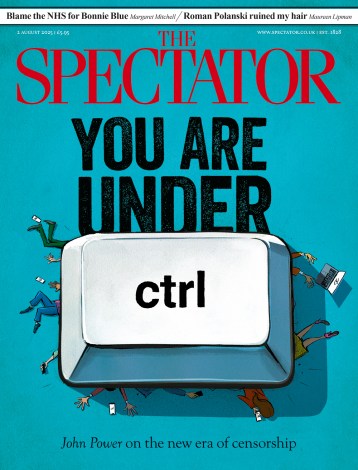In 1787 critics of the Paris Salon were scandalised by a painting exhibited by Mme Vigée Le Brun. The subject was conventional enough: a self-portrait of the artist cradling her small daughter. The problem was that Vigée Le Brun was depicted smiling. You could even see her teeth. This was, as one critic put it, ‘an affectation which artists, connoisseurs and people of good taste are unanimous in condemning’.
These outraged art lovers must have been rather out of touch with current trends. For, as Colin Jones shows in The Smile Revolution — his revealing history of 18th-century French smiling — the full-on, lips-parted sourire had been increasingly visible in Paris since at least the 1740s.
It was a gesture partly intended as an attack on the stiff protocol of the royal court, where the convention was to keep the face as fixed as possible (the rigidity being helped by lashings of thick white make-up, sometimes even covering the lips). If the slightest curl of the mouth was detected, it was taken as a sign of disdain or disapproval, not of pleasure or amusement.
Away from Versailles, in the more relaxed world of the Parisian elite, that
formality was being challenged by a new sensibility. Smiles, teeth and all, were catching on as a sign of true human feeling — so much so, that in Rousseau’s La Nouvelle Héloïse of 1761, the dying heroine even breaks into a smile, amidst the tears of her deathbed. Vigée Le Brun did little more than claim a place for smiling in the most conservative realm of public art. But that was revolutionary enough to annoy the critics.
Smiles are fleeting things. That is partly their point (hence, as Jones observes, their absence from early photographs — it was impossible to hold one for the 30 minutes or more required by the first cameras). But it also makes them very hard for historians to pin down. One problem is quite where the boundary lies between smiling and laughing. Jones is mainly concerned with France, and French (like Latin) calls a ‘smile’ just ‘a sub-laugh’ (sou-rire). But are these actually (as the English language encourages us to think) two very different phenomena? Certainly, babies smile months before they laugh, and they use smiles in very different contexts from laughs.
An even bigger problem is whether smiling is as universal a gesture as we tend to assume. Of course, it may well be that human beings have curled up their lips since time immemorial (it is the most economical facial movement in our repertoire, requiring the operation of only one set of muscles). But the question is whether that curling is culturally assumed to mean something. The flimsy evidence we have suggests that meaningful smiles were at best an intermittent presence in Europe before the Middle Ages (ancient Greece, probably yes; ancient Rome, no).
Jones has a few brisk and sensible words on these issues in his introduction, but for the rest he opts for a much more physical and practical way into the subject — via the history of teeth. Dentists of the 20th century were not the first to sell their skills with the promise of a perfect smile. The rigid closed mouth of the ancien régime was only partly the result of buttoned-up court culture. It was also the result of very bad teeth, which did not look at all attractive on public display. Louis XIV was entirely toothless by the time he was 40, and even his famous portrait by Hyacinthe Rigaud did not manage — or bother — to disguise his wrinkled, sunken mouth.
The new sensibility of smiling was underpinned by the new science of dentistry (the term dentiste and the toothbrush both being inventions of this period). There were small fortunes to be made patching up teeth and replacing those that had been lost. One of the most colourful charlatans in the book is Dubois de Chémant, who sold his vastly expensive, ill-designed, heavy, noisy, porcelain dentures to those with more money than sense. One pristine set was actually found in a grave in St Pancras churchyard a few years ago, in excavations in advance of the Eurostar line.
It turned up in London because that is where the denture trade had been forced to migrate. For, almost as soon as it had begun, the Parisian smile revolution was over-taken by the political revolution. At the start of the new regime, there was a chance that open smiles might have become one symbol of its transformed society. But soon Vigée Le Brun’s seductively open mouth came to hint at counter-revolutionary tendencies, and the Terror ‘wiped the smile of sensibility from French lips’. In fact, in Robespierre’s case, it knocked all his teeth out on the scaffold.
As Jones reflects at the end of his fascinating exploration, it would be another 150 years before smiles really revolutionised the West. This revolution had been a false dawn.






Comments